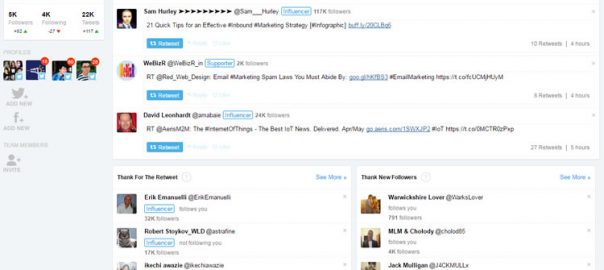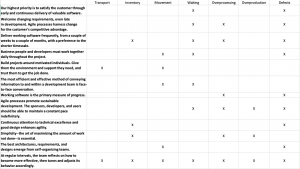
In November 2014, my starter guide for SMM managers went online here at WHSR to help you create a strategy for all the major social media outlets and then some more (including forums).
What that guide lacked – and rightfully so, as that was not the focus of the post – was specific advice for data analysis aimed at planning a strategy to boost user engagement on both social platforms and business blog.
The post you are reading is here to fill that gap.
In fact, knowing how to make the best out of each social channel (social networks, blogs, forums) is not enough – what you need is a method to continually harvest and analyze data from the channels you use to:
- Improve the way you interact with your follower base
- Enhance your efforts to attract more followers and interactions
- Use social factors and analytics data to boost blog following and engagement
Needless to say, the third point in the list is the most important, as your goal is to drive all social media followers to the core of your business: your business website and its blog.
As Will Blunt from Blogger Sidekick puts it in his post about blog metrics:
If you don’t know where you’re going, you won’t know how to get there and you certainly won’t know how to measure if it was successful or not.
What the Statistics Say
HubSpot published an interesting report in September 2015 on what makes the top 10 business blogs successful. It’s interesting to see how these blogs used social media and blogging to stay in the top ranks:
- The frequency of their tweets is slightly higher than other business blogs (7 to 6)
- They get the most social shares for List- and How-to type posts
- They post 8X times more often than other blogs
It’s safe to guess they made good use of their data to know exactly how and how often to post and update their social channels.

Twitter is driving the most traffic to the top 10 business blogs according to HubSpot’s study.
For the specific case of Twitter, a study of 4 million tweets by Stone Temple Consulting “to see what really drives retweets, favorites, and replies” revealed that it’s 3 factors that mainly drive the most engagement on Twitter:
- Including images in your tweets (4X more chances of getting retweets and favorites and about 2X for replies)
- Tweet length of no more than 120 characters (increases chances of retweets and favorites)
- Mentions (might increase chances of retweets)
Other things like hashtags and links, the study found, only moderately increase chances of retweets or favorites, and if they do, it’s probably because of your higher authority.
It makes sense to add these findings to your Twitter strategy then and use the resulting boost in social engagement to bring more visitors and potential users or customers to your blog.
Let’s see now how to turn your social and blog data into useful ideas.
How To Analyze User Interaction On Your Platforms

As a business owner with a website and social presence, fans and visitors will interact with you every day via social channels and blog comments, and more often than not they will leave feedback that is strongly personalized and meaningful.
What to look for?
1. Frequency of interactions
If, for example, you post 10 tweets/day, track which ones get the most retweets, favorites and replies. If you publish 4 new blog posts a month, track which get the most social shares, comments and community discussions.
2. Quality of interactions
If you post a tweet and you only see replies from bots or users saying “Hello, nice one. Follow me?”, there is no real interaction and you get no helpful data to boost engagement. On the contrary, if a fan says “That piece of content you shared was very helpful and solved my problem! Where can I get more?”, this is meaningful interaction and provides you with data you can work with.
3. Statistics
How many new daily interactions do you get? What about new followers? How many new blog comments? Track numbers weekly or monthly and obtain an average to see exactly how you are faring statistically. It helps to evaluate if your social and blogging efforts are bringing you results.
What type of engagement do you want to boost?
- Social Interaction – Replies, comments, retweets, likes, favorites, forum/community discussions.
- Blog Comments – Discussions on a medium you own (your blog) and on all other blog-based media, like your guest posts and your syndicated posts (Medium.com, Kingged.com, etc.).
- More Traffic and a Lower Bounce Rate – More traffic and longer user time on site can lead to increased opt-ins and conversions.
Below is practical advice on relevant metrics.
1. Replies and Comments
By analyzing the quality of conversations and the authority of your commenters, you can assess the strength of attraction of your posts, as well as their appeal to both low and high authority names in your niche or industry.
Questions
- How many comments/replies do you get per post/tweet?
- What is the overall tone of these interactions?
- Are there any commenters who post more often?
- Who are these commenters? Are they influencers/big names in your niche?
Tools & Tips
Keeping track of how many replies you get to your tweets is not trivial unless you know how to implement the APIs, but you can still do it manually with a spreadsheet that lists an accurate selection of all those tweets you posted to spark a conversation.
Look at how I organized mine:

“Tweet Intent” is the scope of your tweet and how it tries to spark conversation. “Reply/Retweet Ratio” helps you track users’ preferred response to your tweets.
You can use this type of spreadsheet for any social network you have a business presence on.
Thankfully, some social platforms make your job easier by giving you built-in analytics that include comments data. For example,
- Facebook comes with a Publishing Tools section for every Page you publish, located at https://www.facebook.com/YOURPAGENAME/publishing_tools/ This section lists your posts and tells you how many Likes, Shares and Comments you received per post
- Tsū provides Analytics with comment data, although in aggregated form, so you will still have to track your posts manually for comments.
If your blog runs on WordPress, you can order your posts by number of comments (in ascending order) by clicking on the comment icon after the Tags column under Posts -> All Posts. Also, you can install a comment analytics plugin called Mini Statistics that will create charts of commenting activity on your blog. Here is a screenshot of the plugin:

If you suspect a commenter is an influencer or a big name in your niche or industry, run a web search for their name and URL (if available) to see who they are and get in touch.
Although quality analysis requires a human eye, you can follow Kristi Hines’ guide to set up blog comments as a Goal in Google Analytics and get some automated help.
Finally, use the questions above and data from your tools as guideposts to:
- Create more content and social posts around the topics that received the most comments (and the most favorable) and especially comments by influencers.
- Create an email outreach campaign to influencers – thank them for contributing to the conversations and invite them to special events or to view content you feel might help them.
- Invite your most loyal commenters to your special mailing list where they will get extra content for free.
- Mention comments from influencers and loyal commenters in your next blog and social posts – make them feel important for the growth of your blog and business.
- Setup a Twitter chat for all your past and present commenters – it will boost Twitter engagement and attract more users to the conversation (and your platforms).
2. Likes, Favorites, +1s
Like/favorite buttons give users a quick way to show preference for your social and blog content.
Questions
- What kind of social post or blog content got the most likes/favorites/+1s?
- Do you get more likes/favorites than reposts/retweets, replies and comments?
Tools & Tips
Insight analytics that each platform gives you are your best friends, but you can also add Google Analytics to the mix and use web apps like Shared Count.
To track and analyze likes/favorites across your social and blog posts, create a spreadsheet like the one used in point #1.
You can also let your visitors add Likes to your blog posts with WP Ulike and add them to your spreadsheet.
3. Retweets and Reposts
Reposts are social posts (Facebook, Google+, Tsu, etc.) that users reshare on their profiles.
About Twitter, as reported by the Stone Temple Consulting research mentioned at the beginning of this post,
36% of all tweets get at least one RT, and 43% of all tweets get at least on Favorite. The story with replies is quite different. Only 0.7% of tweets get a reply.
That means there is a whole lot of broadcasting behavior occurring on Twitter. Engagement is primarily defined by RTs and Favorites.
Questions
- What type of the content you share gets the most retweets or reposts?
- Do at least some of these retweets/reposts come with a comment/message?
Tools & Tips
Keep track of your meaningful tweets and posts and how many retweets and reposts each one gets. You can do this with a spreadsheet as shown earlier. For Twitter, you can use Twitter Analytics to get more insights on engagement, especially for your Top Tweets: https://analytics.twitter.com/user/YOURUSERNAME/tweets?filter=top. Facebook provides insights for pages under the Publishing Tools section.
The number of retweets and reposts and any messages that accompany them tell plenty about what your audience prefers among the contents you promote. Take note.
It may also help to read these posts:
- Measure Twitter Engagement at KISSmetrics
- Google+ Page Performance at Social Media Examiner
- Measure Facebook Engagement at Social Media Examiner
- Pinterest Marketing Success at HubSpot
- Social Engagement Metrics That Matter at MOZ
4. Shares
The number and quality of social shares tell you how popular and share-worthy your content is.
Questions
- What kind of content gets the most shares? If available, why?
- Do your blog posts have share CTAs?
- What do shares tell you about your audience’s preferences?
Tools & Tips
Use a WordPress plugin called WP Social Stats to count shares per post (Twitter, Facebook, Google+, StumbleUpon, LinkedIn and Pinterest) and see which posts of yours got the most shares per platform and across all platforms overall.
You can also use BuzzSumo for the same purpose: input the link of your blog to see which posts got most shares.
The advice given for the previous metrics applies for Shares, too.
5. Traffic Metrics
Traffic relates to how many impressions you get on social channels and pageviews for your blog posts.
Questions
- How many social referrals does your blog get daily? How do they relate to the total number of pageviews?
- How many impressions do you receive per social post/tweet/pin? Which posts/tweets/pins fare best?
- How many views and impressions do actually convert?
Tools & Tips
You can use analytics software – Google Analytics, Piwik, OpenWebAnalytics, WP Statistics (WordPress plugin) – to evaluate your incoming traffic and how much of it comes from social media.

Buyer persona template by Will Blunt.
Will Blunt (the blogger I mentioned in the intro to this post) uses buyer personas to turn pageviews into meaningful data.
In fact, he says,
Measuring pageviews is a complete waste of time if you aren’t deliberate about the people you want on your site, and where you are going to find them.
General traffic numbers won’t give much data to work on, but visitors who come and opt-in or make a purchase will.
6. Social Mentions
This is not about citations on others blogs and websites, but mentions and links on social channels. For example, a user quoting a phrase from your new blog post with a link and your username in a tweet.
Questions
- What’s your most mentioned piece of content?
- What factors led other users to socialize it? (Example: specific mottos, quotes, statistics, etc.)
- What is the context of these mentions?
Tools & Tips
Social Mention is your friend. This is a tool that allows you to search your username, quote or website across multiple social media platforms, including blogs. The tool also reports sentiment analysis, top keywords and top users/hashtags.
For Twitter, you can also use Commun.it’s Who Mentioned Me section and engage with users from there.
More mention notification tools are discussed in point #7 below (e.g. Mention.com).
It’s vital to ask users why they chose to share that specific quote. You can ask them directly with a reply to their post or contact them privately.
Username tags may not be as helpful as mentions, but they can still help you assess your channel’s popularity.

A quick look into WHSR’s commun.it dashboard.
7. Discussions and Mentions Outside of Social Media
This is about non-social mentions, as in bibliographies, articles, forum threads/posts and ebooks. The number and quality of mentions/citations give information on how much authority people give your content.
Questions
- What content gets most discussed, cited and linked to?
- What other products or services linked to your blog get the most mentions and are more popular? (Think your ebooks, infographics, etc.)
- Are any of your posts discussed in online communities like Inbound, Threadwatch, GrowthHackers, etc.?
- Did you get citations from big niche blogs?
Tools & Tips
Use Google Alerts and Mention.com to get mention notifications and evaluate them.
Backlinks also count as citations when they are contextually relevant. You can use Monitor Backlinks, Ahrefs and Open Site Explorer to find and evaluate backlinks.
If you get mentions from authority blogs and news outlets in your niche, that’s an important signal: it means someone with more experience and expertise than you approved of your work and deemed it worthy of reference and recommendation.
The more you tackle vital problems in your niche – and you work hard to promote these posts – the more users will follow your blog and help it scale up popularity ranks. You can help the process with syndication and by creating discussions at communities like Kingged and Inbound.
How To Boost Engagement: What Marketers and Bloggers Say

Because one viewpoint and experience is not enough, I looked for other marketers’ and bloggers’ insight on what data to use (and how to harvest it) to boost engagement.
Elidri
Elidri from DigitalRoom.com suggests a combination of social metrics, comments and demographics to determine what your audience wants:
Social Media is a great source of fast content assessment. As more and more people connect with what you share over in Social Media, you will be able to collect very useful information in their comments, likes, shares, and other metrics. Knowledge of these metrics is essential to the success of your social media and content marketing campaigns.
People often comment the good, the bad, and the ugly about your content. This can either generate more traffic to your website but on the basis that the content is a combination of the three concepts.
Analyzing Social Media Metrics will tell you the following things about your content and website as a whole:
1. Social Media Share determines how useful your content is that people are willing to share it.
2. Comments will provide you bits and pieces of information about your content and will ultimately lead you to what these commenters [desire] in terms of the content they want and need.
3. User location, gender, and other user-centric information provides you the best and most important element of your content marketing. “Your Audience Reach”.
Expanding and shifting this concept will be key to the success of your Social Media Campaign in a Business perspective.
Lori Hil
Lori Hil from Immensely Social uses Pinterest Analytics to evaluate Pinterest engagement in relation to her site:
I use the Pinterest Analytics for Business account to analyze what pins my viewers are most interested in and especially from my site. I can use this information to make my site more Pinterest friendly. I also use it to create niche Pinterest boards that I think my followers will find helpful based on the stats I see. When I see that a pin is popular and pulled traffic back to my site, I can use it as a template in the future.
Ann Smarty
Ann Smarty, founder of MyBlogU, suggests Cyfe for an in-depth and insightful analysis of social media engagement:
Cyfe visualizes and archives some key engagement metrics including likes, comments, clicks, shares, etc. You can add an insane amount of widgets to one dashboard to collect all sorts of data within one dashboard.
While there’s much more into analyzing interaction than tracking numbers, Cyfe is ideal for keeping everything under control without going crazy. I use it to spot social media accounts that need more work, abandoned accounts managed by team members, engagement spikes (to analyze what happened and replicate), etc.
Ann also shared her dashboard screenshot:

Ann Smarty’s Cyfe dashboard (2015-12-11)
Don Seckler
Don Seckler from Peak Inbound Marketing suggests you work on increasing blog engagement with the help of social media in two steps:
First, create social posts that have value to your followers. Help them in some way. When you solve problems for your followers they find that kind of content very valuable.
Second, always include a link back to a longer piece of valuable content that has all the details.
Paul Manwaring
Paul Manwaring from Outsprung makes use of a combination of SocialBro, Buffer, Twitter Ads and spreadsheets to collect and analyze social engagement data:
Something I do once or twice a month is run the ‘best time to tweet’ report on Social Bro. I then sync my Buffer calendar to this to make sure that, when I post, it’s reaching the maximum amount of my Twitter followers.
Another thing you can do is sign up to Twitter Ads and then view your posts analytics, it gives you a wealth of stats and engagement rates. You can export this to Excel and then sort by highest engagement rate to see what is performing best.
I did it and realized that my replies to other people’s tweets actually got the highest engagements, I concluded that it was probably because I brought up a counter argument or just came across more human, seeing as most Twitter accounts just spam their blog posts.
Matthew Gates
Matthew Gates from Confessions of the Professions doesn’t deem analytics software or comments tracking necessary for data collection and evaluation. Here is what he does instead:
Although I do keep Google Analytics installed on my site, it is probably the most useless tool to me for my needs. I thought it would help, but the data from it seems off, a lot off, and its probably because of other things going on with my website. For example, my website has an 80% bounce rate. At one time, it had a 30% bounce rate. Yet, WordPress Jetpack gives me completely different results and shows me even better user engagement. Anyways, I have some social media tools on my website, and using JetPack, I have it so that when people share, they @ mentions me with what they shared and it gets sent to me via email.
Those hundreds of emails let me know that people are reading my articles. I also have a plugin that scans Twitter for those same messages and posts them as comments on my blog, which lets me know who shared those articles. I also have a visit count on every page, so I can see how much pages are getting visited. On top of that is another plugin that shows you what pages people are currently reading or have read in the past 5 to 10 minutes.
I wish I had more engaging comments, but my site is just not like that. I have contributors who publish their articles, but who wants to keep checking for new comments? I do lack that particular technology to email contributors of new comments, but it’s not the end of the world. So measure of engagement and interaction with my website? I use Jetpack and Twitter @mentions to figure out how popular an article is.
Doyan Wilfred
Doyan Wilfred from HowToGetMoreSalesOnline.com uses a number of platforms and softwares for social post automation and analysis, and always gets in touch with influencers and loyal followers:
I use Buffer to automate post updates [and] Hootsuite to monitor mentions. I also use Commun.it to track engagement and thank my influencers and most engaged followers. I make sure to thank anyone engaging with me, be it like, share, retweet, mention or a private message.
I use Google Analytics and Twitter’s built-in analytics to track where my visitors are coming from. In the future, I plan to set up separate landing pages for users coming from different channels.
Takeaway
When you analyze user interaction, don’t stop at numbers – more than quantitative data, you need qualitative data, and that only comes from relationships: the human factor plays a crucial role to attract more users and get them to interact, opt-in and participate or buy.
Ultimately, you are looking for data that speaks of a community around your blog or business.
You may want to read Michael Patterson’s 4 Social Media Reports That Will Boost Your Audience Engagement post at Kissmetrics and Jeffrey Kranz’s 7 Social Media Engagement Metrics for Tracking Followers and Growing Community at Buffer to improve your plan.
Finally, I feel it’s worth citing this interesting study about engagement factors in social media:
Digital & Social Articles on Business 2 Community
What we found as the potential important factors to consider (…) are social media activation mechanism and its flexibility to meet consumer and participants expectations, interaction design based on simplicity and perceptual choices capable to prolong engagement, actionable timing based on participants behavior patterns and listening of the community and proven care for the community such as taking care of the potential and detected frauds.
(75)
Report Post






